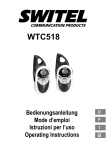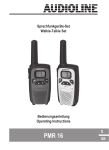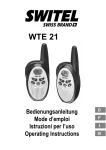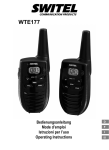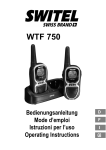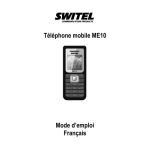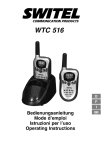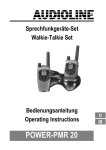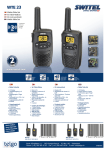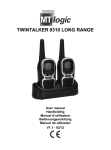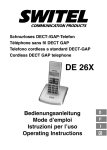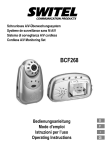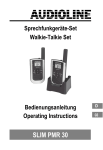Download WTC520
Transcript
WTC520 Bedienungsanleitung Mode d’emploi Istruzioni per l’uso Operating Instructions Bedienungsanleitung . . . . . . . . . . . 3 Mode d’emploi . . . . . . . . . . . . . . 11 Istruzioni per l’uso . . . . . . . . . . . . 19 Operating Instructions . . . . . . . . . 27 Declaration of Conformity . . . . . . . 36 2 Sicherheitshinweise 1 Sicherheitshinweise Lesen Sie diese Bedienungsanleitung sorgfältig durch. Bestimmungsgemäße Verwendung Diese Sprechfunkgeräte sind geeignet für die Kommunikation mit anderen Sprechfunkgeräten gleichen Standards. Jede andere Verwendung gilt als nicht bestimmungsgemäß. Eigenmächtige Veränderungen oder Umbauten sind nicht zulässig. Öffnen Sie die Geräte in keinem Fall selbst und führen Sie keine eigenen Reparaturversuche durch. Verwendungsbereich Vermeiden Sie Belastungen durch Rauch, Staub, Erschütterungen, Chemikalien, Feuchtigkeit, Hitze oder direkte Sonneneinstrahlung. Verwenden Sie die Funkgeräte nicht in explosionsgefährdeten Bereichen. Netzteil Achtung: Verwenden Sie nur das mitgelieferte Steckernetzteil, da andere Netzteile die Funkgeräte zerstören können. Sie dürfen den Zugang zum Steckernetzteil nicht durch Möbel oder andere Gegenstände versperren. Aufladbare Akkus Achtung: Werfen Sie Akkus nicht ins Feuer. Verwenden Sie nur Akkus des gleichen Typs! Achten Sie auf die richtige Polung! Bei verkehrter Polung der Akkus besteht beim Aufladen Explosionsgefahr. Medizinische Geräte Achtung: Benutzen Sie die Funkgeräte nicht in der Nähe von medizinischen Geräten. Eine Beeinflussung kann nicht völlig ausgeschlossen werden. Funkgeräte können in Hörgeräten einen unangenehmen Brummton verursachen. Entsorgung Sie sind gesetzlich zur sachgerechten Entsorgung von Gebrauchsgütern verpflichtet. Das nebenstehende Symbol bedeutet, dass elektrische und elektronische Altgeräte und Akkus getrennt vom Hausmüll zu entsorgen sind. Elektrische oder elektronische Geräte entsorgen Sie bei einer Sammelstelle eines geeigneten Entsorgungsträgers. Akkus entsorgen Sie beim batterievertreibenden Handel sowie bei zuständigen Sammelstellen, die entsprechende Behälter bereitstellen. Verpackungsmaterialien entsorgen Sie entsprechend den lokalen Vorschriften. 3 Funkgeräte in Betrieb nehmen 2 Funkgeräte in Betrieb nehmen Sicherheitshinweise Achtung: Lesen Sie vor der Inbetriebnahme unbedingt die Sicherheitshinweise in Kapitel 1. Verpackungsinhalt prüfen Zum Lieferumfang gehören: − zwei Funkgeräte mit Gürtelclip − zwei Akkupacks − eine Bedienungsanleitung − ein Netzteil Akkupack einlegen Öffnen Sie das Akkufach. Legen Sie den mitgelieferten Akkupack ein. Achten Sie auf die richtige Polung! Schließen Sie das Akkufach. Achtung: Standard Akkus und Batterien werden nicht geladen. Verwenden Sie nur den mitgelieferten Akkupack oder Akkupacks der gleichen Bauweise. Akkupacks aufladen Schließen Sie die Funkgeräte wie auf der Skizze abgebildet an. Verwenden Sie aus Sicherheitsgründen nur das mitgelieferte Netzteil. Netzsteckdose Laden Sie die Funkgeräte vor der ersten Inbetriebnahme für mindestens 14 Stunden. 4 Bedienelemente Wenn Sie die Funkgeräte korrekt angeschlossen haben, leuchten die roten LEDs. Diese signalisieren lediglich den korrekten Anschluss und erlöschen auch bei vollständig geladenen Akkupacks nicht. Laden Sie die Akkupacks nicht mit fremden Aufladegeräten. Der aktuelle Akkuladezustand wird im Display angezeigt: voll halb leer Sobald die Anzeige im Display blinkt und Warntöne zu hören sind, muss der Akkupack aufgeladen werden. Gürtelclip anbringen Schieben Sie den Gürtelclip von oben in die Führung, bis er hörbar einrastet. Um den Gürtelclip wieder zu entfernen, heben Sie die Befestigungslasche mit dem Fingernagel etwas an und schieben den Gürtelclip nach oben. 3 Bedienelemente Die Tasten Ihres Telefons werden in dieser Bedienungsanleitung nachfolgend mit vereinheitlichten Symbolen dargestellt. Leichte Abweichungen der Tastensymbole Ihres Telefons gegenüber den hier verwendeten Tastensymbolen sind daher möglich. Mobilteil 1 2 3 4 5 6 Display Lautstärke, Einstellung aufwärts Lautstärke, Einstellung abwärts Menü PTT−Taste Rufton senden 1 6 5 4 2 3 5 Wie bediene ich meine Funkgeräte? Display 1 1 2 3 4 5 6 6 4 2 3 Batteriekapazität Tastensperre CTCSS−Code Kanal Kanalsuche Lautstärke 5 4 Wie bediene ich meine Funkgeräte? Darstellungen und Schreibweisen P a, P Abgebildete Taste drücken Abgebildete Taste lange drücken b, P Abgebildete Taste loslassen [ y ] Displayanzeige ð In das Mikrofon sprechen Ein− / Ausschalten der Funkgeräte 1 aM Funkgerät einschalten Es erklingt ein Signal. Im Display wird der aktuell eingestellte Kanal angezeigt. aM Funkgerät ausschalten Lautstärkeregelung : oder ; lauter oder leiser Senden und Empfangen Senden 2 Wird die Taste P länger als 60 Sekunden gedrückt, ertönt ein Warnton. Die Übertragung wird unterbrochen. a, P, ð Senden Halten Sie das Funkgerät ca. 5 bis 7 cm vom Mund entfernt und sprechen Sie mit normaler Lautstärke. Um mit anderen Teilnehmern zu sprechen, müssen alle Funkgeräte auf den gleichen Kanal und CTCSS−Code eingestellt sein. Empfangen 3 b, P Empfangen Sie können keine Funksignale empfangen, wenn Sie die Taste P gedrückt halten. 6 Wie bediene ich meine Funkgeräte? Kanalwahl M Einstellungsmodus aktivieren : oder ;, P Kanal auswählen und bestätigen Kanal Frequenz (MHz) Kanal Frequenz (MHz) 1 446.00625 5 446.05625 2 446.01875 6 446.06875 3 446.03125 7 446.08125 4 446.04375 8 446.09375 CTCSS−Code wählen Es werden alle Gespräche an Funkgeräten signalisiert, die sich im Empfangsbereich befinden. Voraussetzung dafür ist, dass alle Funkgeräte auf den gleichen Kanal eingestellt sind. Um gegenseitige Störungen zu vermeiden, kann auf dem eingestellten Kanal ein CTCSS−Code festgelegt werden. Es können 38 CTCSS−Codes je Kanal eingestellt werden. 2xM Einstellungsmodus aktivieren : oder ;, P CTCSS−Code auswählen und bestätigen Jeder CTCSS−Code entspricht einer bestimmten Tonfrequenz, die das Sprechfunkgerät sendet. Die Kommunikation zwischen zwei Teilnehmern ist nur dann möglich, wenn beide denselben Kanal und CTCSS−Code verwenden. Eine Ausnahme ist der CTCSS−Code 0". Bei dieser Einstellung können, unabhängig vom CTCSS−Code, alle Gespräche auf dem eingestellten Kanal gehört werden. Um am Funkverkehr teilnehmen zu können, muss dann ggf. vom CTCSS−Code 0" auf den verwendeten CTCSS− Code gewechselt werden. Wenn Sie mit Funkgeräten kommunizieren möchten, die keinen CTCSS−Code verwenden, müssen Sie an Ihrem Funkgerät den CTCSS−Code 0" auswählen. Kanalsuche In einer Endlosschleife wird auf den acht Kanälen nach Signalen gesucht. Im Display −Symbol. Wird ein aktiver Kanal gefunden, stoppt die Kanalsuche. erscheint das Drücken Sie die Taste P, um am Funkverkehr teilzunehmen. Wenn Sie die Taste P nicht drücken, wird die Kanalsuche nach fünf Sekunden fortgesetzt. Kanalsuche starten 4xM Einstellungsmodus aktivieren : [ y ], P Kanalsuche starten Kanalsuche beenden 4xM :[ − 1 Einstellungsmodus aktivieren ], P Kanalsuche beenden CTCSS: Continous Tone Coded Squelch System = Selektivruf 7 Wie bediene ich meine Funkgeräte? Kanalsuche fortsetzen : oder ; Kanalsuche fortsetzen Rufton senden Der Rufton macht andere Teilnehmer darauf aufmerksam, dass Sie ein Gespräch beginnen möchten. Voraussetzung dafür ist, dass die anderen Teilnehmer den gleichen Kanal und CTCSS−Code verwenden. T Rufton senden Rufton wählen / ausschalten Sie haben 5 Ruftöne zur Auswahl. Um den Rufton auszuschalten wählen Sie die Einstellung 0". 3xM Einstellungsmodus aktivieren : oder ;, P Rufton auswählen und bestätigen Monitor Die Monitor−Funktion ermöglicht es Ihnen auf dem aktuell eingestellten Kanal nach schwachen Signalen zu suchen. Wenn Sie ein fremdes Signal empfangen, wechseln Sie auf einen freien Kanal. Kommunizieren Sie mit anderen Teilnehmern immer auf einem freien Kanal, um Störungen zu vermeiden. 6xM Kanal abhören P Abhören beenden Tastensperre Die Tastensperre verhindert das ungewollte Ändern von Einstellungen. Bei eingeschalteter Tastensperre erscheint das −Symbol im Display. Aktivieren 4 5xM Einstellungsmodus aktivieren : [ y ], P Tastensperre aktivieren Deaktivieren 5 a, M 8 Tastensperre deaktivieren Falls es Probleme gibt 5 Falls es Probleme gibt Haben Sie Probleme mit Ihren Funkgeräten, kontrollieren Sie zuerst die folgenden Hinweise. Bei Garantieansprüchen wenden Sie sich an Ihren Fachhändler. Die Garantiezeit beträgt 2 Jahre. Fragen und Antworten 6 Fragen Antworten Keine Funktion − Akkupack nicht geladen − Tastensperre aktiviert Senden nicht möglich − Taste P zum Senden vollständig drücken − Kanal wird von anderen Teilnehmern benutzt Kein Empfang − Taste P loslassen − Lautstärke zu gering eingestellt − Sie befinden sich außerhalb des Empfangsbereiches, ändern Sie Ihre Position − Hindernisse wie Bäume und Gebäude haben einen negativen Einfluss auf die Reichweite − CTCSS−Code ist nicht identisch mit dem des Gesprächspartners − Kanal wird von anderen Teilnehmern benutzt Technische Eigenschaften Technische Daten Merkmal Wert Ausgangsleistung 0.5 W Reichweite ca. 5 km − bei freier Sichtlinie Akkupack NiMh 3.6V, 600mAh Konformitätserklärung Dieses Gerät erfüllt die Anforderungen der EU−Richtlinie: 1999/5/EG Richtlinie über Funkanlagen und Telekommunikationsendeinrichtungen und die gegenseitige Anerkennung ihrer Konformität. Die Konformität mit der o. a. Richtlinie wird durch das CE−Zeichen auf dem Gerät bestätigt. 9 Pflegehinweise / Garantie 7 Pflegehinweise / Garantie Pflegehinweise Reinigen Sie die Gehäuseoberflächen mit einem weichen und fusselfreien Tuch. Verwenden Sie keine Reinigungsmittel oder Lösungsmittel. Garantie SWITEL − Geräte werden nach den modernsten Produktionsverfahren hergestellt und geprüft. Ausgesuchte Materialien und hoch entwickelte Technologien sorgen für einwandfreie Funktion und lange Lebensdauer. Ein Garantiefall liegt nicht vor, wenn die Ursache einer Fehlfunktion des Gerätes bei dem Telefonnetzbetreiber oder einer eventuell zwischengeschalteten Nebenstellenanlage liegt. Die Garantie gilt nicht für die in den Produkten verwendeten Batterien, Akkus oder Akkupacks. Die Garantiezeit beträgt 24 Monate, gerechnet vom Tage des Kaufs. Innerhalb der Garantiezeit werden alle Mängel, die auf Material− oder Herstellungsfehler zurückzuführen sind, kostenlos beseitigt. Der Garantieanspruch erlischt bei Eingriffen durch den Käufer oder durch Dritte. Schäden, die durch unsachgemäße Behandlung oder Bedienung, natürliche Abnutzung, durch falsches Aufstellen oder Aufbewahren, durch unsachgemäßen Anschluss oder Installation sowie durch höhere Gewalt oder sonstige äußere Einflüsse entstehen, fallen nicht unter die Garantieleistung. Wir behalten uns vor, bei Reklamationen die defekten Teile auszubessern, zu ersetzen oder das Gerät auszutauschen. Ausgetauschte Teile oder ausgetauschte Geräte gehen in unser Eigentum über. Schadenersatzansprüche sind ausgeschlossen, soweit sie nicht auf Vorsatz oder grober Fahrlässigkeit des Herstellers beruhen. Sollte Ihr Gerät dennoch einen Defekt innerhalb der Garantiezeit aufweisen, wenden Sie sich bitte unter Vorlage Ihrer Kaufquittung ausschließlich an das Geschäft, in dem Sie Ihr SWITEL − Gerät gekauft haben. Alle Gewährleistungsansprüche nach diesen Bestimmungen sind ausschließlich gegenüber Ihrem Fachhändler geltend zu machen. Nach Ablauf von zwei Jahren nach Kauf und Übergabe unserer Produkte können Gewährleistungsrechte nicht mehr geltend gemacht werden. 10 Consignes de sécurité 1 Consignes de sécurité Lisez très attentivement ce mode d’emploi. Utilisation conforme aux prescriptions Ces émetteurs−récepteurs conviennent pour la communication avec d’autres émetteurs−récepteurs de même standard. Toute autre utilisation est considérée comme non conforme à l’usage. Des modifications ou changements effectués d’un propre gré ne sont pas autorisés. N’ouvrez en aucun cas les appareils et n’effectuez aucun essai de réparation vous−même. Lieu d’utilisation Eviter les nuisances par la fumée, la poussière, les tremblements, les produits chimiques, l’humidité, la grande chaleur ou l’ensoleillement direct. N’utilisez pas les émetteurs−récepteurs dans des pièces exposées aux explosions. Bloc secteur Attention : N’utilisez que le bloc d’alimentation enfichable fourni avec l’appareil, d’autres pouvant détruire les émetteurs−récepteurs. Vous ne devez pas bloquer son accès par des meubles ou autres objets. Piles rechargeables Attention : Ne jetez jamais les piles rechargeables dans le feu. N’utilisez que des piles rechargeables du même type ! Observez une polarisation correcte ! Risque d’explosion lors de leur chargement si la polarisation est incorrecte. Appareils médicaux Attention : N’utilisez pas les émetteurs−récepteurs à proximité d’appareils médicaux. Une influence ne peut pas être totalement exclue. Ces appareils peuvent causer un bourdonnement désagréable dans les prothèses auditives. Elimination La loi vous oblige à éliminer de manière appropriée les biens de consommation. Le symbole placé ci−contre signifie que les anciens appareils électriques et électroniques ainsi que les piles rechargeables ne doivent pas être éliminés avec les ordures ménagères normales. Éliminez les appareils électriques ou électroniques dans le centre de collecte d’un organisme approprié d’évacuation des déchets. Éliminez les piles auprès d’un revendeur spécialisé ainsi que dans des centres de collecte qui tiennent à votre disposition les collecteurs appropriés correspondants. Éliminez les matériaux d’emballage conformément au règlement local. 11 Mise en service des émetteurs−récepteurs 2 Mise en service des émetteurs−récepteurs Remarques concernant la sécurité Attention : Avant de mettre votre appareil en service, lisez impérativement les consignes de sécurité mentionnées au chapitre 1. Vérifier le contenu de l’emballage Les éléments suivants font partie de la livraison : − deux émetteurs−récepteurs avec clip de ceinture − deux packs de piles rechargeables − un mode d’emploi − un bloc d’alimentation Insérer le pack de piles rechargeables Ouvrez le compartiment à piles. Insérez le pack de piles rechargeables fourni avec l’appareil. Observez une polarisation correcte ! Fermez le compartiment à piles. Attention : Les piles rechargeables standard et les batteries ne sont pas chargées. N’utilisez que le pack de piles rechargeables fourni avec l’appareil ou des packs de piles rechargeables du même type. Charger les packs de piles Raccordez les émetteurs−récepteurs tel que représenté sur le croquis. Pour des raisons de sécurité, n’utilisez que le bloc d’alimentation fourni avec l’appareil. Prise réseau 12 Eléments de manipulation Avant la première mise en service, chargez les émetteurs−récepteurs pendant un minimum de 14 heures. Quand ils sont raccordés correctement, les DELs rouges s’allument. Celles−ci signalisent uniquement un raccordement correct et s’éteignent lorsque les packs de piles sont complètement chargés. Ne chargez pas les packs de piles avec des chargeurs d’un autre fabricant. Le niveau actuel de chargement des piles est affiché sur l’écran : Plein Moyen Vide Dès que l’affichage clignote à l’écran et que des signaux sonores d’avertissement se font entendre, le pack de piles rechargeables doit être rechargé. Poser le clip de ceinture Introduisez le clip de ceinture par le haut dans le guidage jusqu’à ce qu’il s’enclenche. Pour l’enlever, soulevez légèrement la languette de fixation avec l’ongle et poussez le clip vers le haut. 3 Eléments de manipulation Dans ce mode d’emploi, les touches de votre téléphone seront représentées par la suite par des icônes standardisées. Aussi des différences entre les icônes des touches de votre téléphone par rapport à ceux utilisés ici sont−elles possibles. Combiné 1 2 3 4 5 6 Ecran Volume sonore, augmenter Volume sonore, diminuer Menu Touche PTT Émettre une sonnerie 1 6 5 4 2 3 13 Comment vous servir de vos émet.−récep. ? Écran 1 1 2 3 4 5 6 6 4 2 3 Capacité des piles Verrouillage du clavier Code CTCSS Canal Recherche du canal Volume sonore 5 4 Comment vous servir de vos émet.−récep. ? Représentations et notations P Appuyer sur la touche représentée a, P Appuyer longuement sur la touché représentée b, P Relâcher la touche représentée [ y ] Affichage ð Parler dans le microphone Brancher / Débrancher les émetteurs−récepteurs 6 aM Brancher l’émetteur−récepteur Un signal sonore se fait entendre. Le canal programmé actuellement est affiché à l’écran. aM Débrancher l’émetteur−récepteur Réglage du volume sonore : ou ; plus fort ou plus bas Émettre et recevoir Émission 7 Si vous appuyez sur la touche P pendant plus de 60 secondes, un signal sonore d’avertissement se fait entendre. La transmission est interrompue. a, P, ð Emission Tenez l’émetteur−récepteur à environ 5 à 7 cm de votre bouche et parlez avec un volume sonore normal. Pour parler avec d’autres correspondants, il faut que tous les appareils soient réglés sur le même canal et sur le même code CTCSS. Réception 8 b, P Réception Vous ne pouvez pas recevoir de signaux radio si vous maintenez appuyée la touche P. 14 Comment vous servir de vos émet.−récep. ? Choix du canal M Activer le mode de programmation : ou ;, P Sélectionner le canal et confirmer Canal Fréquence (MHz) Canal Fréquence (MHz) 1 446.00625 5 446.05625 2 446.01875 6 446.06875 3 446.03125 7 446.08125 4 446.04375 8 446.09375 Sélectionner le code CTCSS Toutes les communications sont signalisées aux émetteurs−récepteurs qui se trouvent dans la zone desservie à condition que tous les émetteurs−récepteurs soient réglés sur le même canal. Pour éviter des interactions, on peut déterminer un code CTCSS sur le canal paramétré. 38 codes peuvent être programmés par canal. 2xM Activer le mode de programmation : ou ;, P Sélectionner le code CTCSS et confirmer Chaque code CTCSS correspond à une certaine fréquence acoustique émise par l’émetteur−récepteur. La communication entre deux correspondants n’est alors possible que si les deux utilisent le même canal et le même code CTCSS. Le code CTCSS 0" fait exception. Dans le cas de ce paramétrage, toutes les communications peuvent être entendues sur le canal paramétré, indépendamment du code CTCSS. Pour pouvoir participer au contact radio, il faut alors, le cas échéant, passer du code CTCSS 0" au code CTCSS utilisé. Si vous désirez communiquer avec des émetteurs−récepteurs n’utilisant pas de code CTCSS, vous devez sélectionner le code CTCSS "0" sur votre émetteur−récepteur. Recherche de canal Dans une boucle infinie, l’appareil cherche des signaux sur les huit canaux. Le symbole apparaît à l’écran. Si un canal actif est trouvé, la recherche de canal s’arrête. Appuyez sur la touche P pour participer au contact radio. Si vous n’appuyez pas sur la touche P, la recherche de canal se poursuivra au bout de cinq secondes. Démarrage de la recherche du canal 4xM :[ Activer le mode de programmation y ], P Démarrer la recherche du canal Terminer la recherche du canal 4xM :[ 1 Activer le mode de programmation − ], P Terminer la recherche du canal CTCSS: Continous Tone Coded Squelch System = Appel sélectif 15 Comment vous servir de vos émet.−récep. ? Continuer la recherche de canal : ou ; Continuer la recherche de canal Émettre une mélodie La sonnerie fait remarquer à d’autres correspondants que vous désirez entamer une conversation. A condition que les autres correspondants utilisent le même canal et le même code CTCSS. T Emission d’une sonnerie Sélectionner / Débrancher la sonnerie Vous avez 5 sonneries à votre disposition. Pour désactiver la sonnerie, sélectionnez le paramétrage 0". 3xM Activer le mode de programmation : ou ;, P Sélectionner la sonnerie et confirmer Ecran La fonction d’écran vous permet de chercher les signaux faibles sur le canal actuellement programmé. Si vous recevez un signal étranger, passez sur un canal libre. Communiquez toujours avec d’autres correspondants sur un canal libre pour éviter les perturbations. 6xM Écouter le canal P Terminer l’écoute Verrouillage du clavier Le verrouillage du clavier empêche la modification involontaire des paramétrages. Si le verrouillage du clavier est activé, le symbole apparaît à l’écran. Activer 9 5xM :[ Activer le mode de programmation y ], P Activer le verrouillage du clavier Désactiver 10 a, M 16 Désactiver le verrouillage du clavier En cas de problèmes 5 En cas de problèmes Si vous avez des problèmes avec vos émetteurs−récepteurs, contrôlez d’abord les remarques suivantes. Si vous avez des droits de garantie, adressez−vous à votre revendeur. La durée de la garantie est de 2 ans. Questions et réponses 6 Questions Réponses Pas de fonction − Le pack de piles rechargeables n’est pas chargé − Le verrouillage du clavier est activé Emission pas possible − Appuyer entièrement sur la touche P pour émettre − Le canal est utilisé par d’autres correspondants Pas de réception − Relâcher la touche P − Volume sonore réglé trop faiblement − Vous vous trouvez en dehors de la zone desservie, modifiez votre position − Des obstacles, comme des arbres ou des bâtiments, exercent une influence négative sur la portée − Le code CTCSS n’est pas identique à celui du correspondant − Le canal est utilisé par d’autres correspondants Caractéristiques techniques Données techniques Caractéristique Valeur Puissance de sortie 0.5 W Portée env. 5 km − si ligne visuelle libre Pack de piles rechargeables NiMh 3.6V, 600mAh Déclaration de conformité Cet appareil répond aux exigences des directives de l’union européenne (UE) : 1999/5/CE Directive sur les installations de radio et de télécommunication et la reconnaissance réciproque de leur conformité. La conformité avec la directive mentionnée ci−dessus est confirmée sur l’appareil par le symbole CE. 17 Remarques d’entretien / Garantie 7 Remarques d’entretien / Garantie Remarques d’entretien Nettoyez les surfaces du boîtier avec un chiffon doux et non pelucheux. N’utilisez pas de produits d’entretien ou de solvants. Garantie Les appareils SWITEL sont fabriqués selon les procédes les plus modernes et sont contrôlés. Des matériels sélectionnés et des technologies de pointe ont pour effet un fonctionnement irréprochable et une longue durée de vie. La garantie ne rentre pas en jeu si l’exploitant du réseau téléphonique ou une installation à postes supplémentaires éventuellement intercalée est responsable du dysfonctionnement de l’appareil. La garantie n’est pas valable pour les piles, piles rechargeables ou packs de piles utilisés dans le produits. La durée de la garantie est de 24 mois, à partir de la date d’achat. Pendant la durée de la garantie, tous les défauts dus à des vices de matériel ou de fabrication seront éliminés gratuitement. Le droit à la garantie expire en cas d’intervention de l’acheteur ou de tiers. Les dommages provenant d’un maniement ou d’une manipulation incorrects, d’une usure naturelle, d’une mauvaise mise en place ou d’une mauvaise conservation, d’un raccordement ou d’une installation incorrects ainsi que d’un cas de force majeure ou autres influences extérieures sont exclus de la garantie. Nous nous reservons le droit, en cas de réclamations, de réparer ou de remplacer les composants défectueux ou d’échanger l’appareil. Les composants remplacés ou les appareils échangés deviennent notre propriété. Les demandes de dommages et intérêts sont exclues tant qu’elles ne reposent pas sur l’intention ou une négligence grossière du fabricant. Si votre appareil devait malgré tout présenter une défectuosité pendant la période de garantie, veuillez vous adressez, muni de la quittance d’achat, exclusivement au magasin où vous avez acheté votre appareil SWITEL. Vous ne pouvez faire valoir vos droits à la garantie selon ces dispositions qu’auprès de votre revendeur exclusivement. Deux ans après l’achat et la remise de nos produits, il n’est plus possible de faire valoir les droits à la garantie. 18 Indicazioni di sicurezza 1 Indicazioni di sicurezza Leggere attentamente le presenti istruzioni per l’uso. Impiego conforme agli usi previsti Questi ricetrasmettitori si prestano alla comunicazione con altri apparecchi ricetrasmittenti aventi lo stesso standard. Qualsiasi altro impiego è considerato come non conforme agli usi previsti. Non sono consentite modifiche o trasformazioni non autorizzate. Non aprire per nessuna ragione gli apparecchi autonomamente ed evitare di compiere riparazioni di propria iniziativa. Ambito di impiego Evitare un’esposizione a fumo, polvere, vibrazioni, sostanze chimiche, umidità, calore e raggi solari diretti. Non utilizzare i radiotrasmettitori in aree esposte al rischio di deflagrazione. Alimentatore di rete Attenzione: Utilizzare esclusivamente l’alimentatore a spina fornito in dotazione visto che altri alimentatori di rete potrebbero addirittura danneggiare i radiotrasmettitori. Non ostacolare il libero accesso all’alimentatore a spina con mobili o altri oggetti simili. Batterie ricaricabili Attenzione: Non gettare le batterie nel fuoco. Utilizzare solo batterie dello stesso tipo! Osservare la corretta polarità! In caso di inversione dei poli delle batterie sussiste il pericolo di esplosione. Apparecchiature mediche Attenzione: Evitare di utilizzare i radiotrasmettitori nelle vicinanze di apparecchiature mediche. Non è possibile escludere completamente il rischio di eventuali interferenze. Radiotrasmettitori possono causare un fastidioso ronzio in apparecchi acustici. Smaltimento Sussiste l’obbligo legislativo al corretto smaltimento di beni di consumo. Il simbolo raffigurato qui a lato indica che apparecchi elettrici ed elettronici usati e batterie esauste non sono da smaltire assieme ai normali rifiuti domestici. Procedere allo smaltimento di apparecchi elettrici o elettronici presso un centro di raccolta incaricato con lo smaltimento conforme. Consegnare batterie ed accumulatori per lo smaltimento presso rivenditori al dettaglio di batterie o centri di raccolta che mettono a disposizione appositi contenitori. Smaltire confezioni ed imballaggi in base a quanto indicato dalle norme in vigore a livello locale. 19 Mettere in funzione i radiotrasmettitori 2 Mettere in funzione i radiotrasmettitori Indicazioni di sicurezza Attenzione: Prima della messa in funzione, leggere attentamente le indicazioni di sicurezza riportate al capitolo 1. Verificare il contenuto della confezione La confezione contiene: − due radiotrasmettitori con gancio per cintura − due accumulatori ricaricabili − un manuale di istruzioni per l’uso − un alimentatore di rete Inserire l’accumulatore ricaricabile Aprire il vano accumulatore. Inserire l’accumulatore ricaricabile fornito in dotazione. Osservare la corretta polarità! Chiudere infine il vano accumulatore. Attenzione: Accumulatori e batterie standard non sono caricati. Utilizzare solo l’accumulatore ricaricabile fornito in dotazione o accumulatori ricaricabili dello stesso tipo costruttivo. Caricare gli accumulatori ricaricabili Procedere al collegamento dei radiotrasmettitori seguendo quanto raffigurato sul disegno. Si consiglia di utilizzare per motivi di sicurezza soltanto l’alimentatore fornito in dotazione. Presa elettrica Caricare i radiotrasmettitori prima della messa in funzione per minimo 14 ore. Non appena i radiotrasmettitori sono stati collegati correttamente, i LED rossi si accendono. 20 Elementi di comando Questi segnalano soltanto il corretto collegamento e non si spengono neanche con accumulatori ricaricabili completamente carichi. Evitare di caricare gli accumulatori ricaricabili con dispositivi di carica differenti o estranei. Lo stato di carica attuale è visualizzato sul display: Carico A metà Scarico Non appena l’indicazione sul display lampeggia e si avvertono dei suoni di avviso è necessario provvedere alla ricarica degli accumulatori. Montare il gancio per cintura Introdurre il gancio per cintura dall’alto nella guida fino a farlo scattare in posizione. Per rimuovere nuovamente il gancio per cintura, sollevare leggermente la linguetta di fissaggio con l’unghia del dito spingendo il gancio per cintura verso sopra. 3 Elementi di comando I tasti del telefono riportati nel presente manuale d’istruzioni per l’uso sono raffigurati sotto forma di simboli uniformi. Sono pertanto possibili lievi scostamenti dei simboli dei tasti sul telefono rispetto ai simboli qui raffigurati. Unità portatile 1 2 3 4 5 6 Display Volume, impostazione verso sopra Volume, impostazione verso sotto Menu Tasto PTT Trasmettere segnale di chiamata 1 6 5 4 2 3 21 Come funzionano i miei radiotrasmettitori? Display 1 1 2 3 4 5 6 6 4 2 3 Capacità di carica batterie Blocco tastiera Codice CTCSS Canale Funzione di ricerca canale Volume 5 4 Come funzionano i miei radiotrasmettitori? Rappresentazioni e modi di scrittura P a, P Premere il tasto raffigurato Premere a lungo il tasto raffigurato b, P Rilasciare il tasto raffigurato [ y ] Visualizzazione di display ð Parlare rivolti verso il microfono Attivare / Disattivare i radiotrasmettitori 11 aM Attivare il radiotrasmettitore Si avverte un segnale acustico. Il canale attualmente impostato è visualizzato sul display. aM Disattivare il radiotrasmettitore Regolazione del volume :o; più alto o più basso Trasmettere e ricevere Trasmettere 12 Se il tasto P viene premuto più di 60 secondi, si avverte un suono di avviso. La trasmissione è quindi interrotta. a, P, ð Trasmettere Mantenere con il radiotrasmettitore una distanza di ca. 5 − 7 cm dalla bocca e parlare con voce normale. Per poter comunicare con altri interlocutori, tutti i radiotrasmettitori devono essere impostati sullo stesso canale e sullo stesso codice CTCSS. Ricevere 13 b, P Ricevere Non è possibile ricevere alcun segnale radio se si tiene premuto il tasto P. 22 Come funzionano i miei radiotrasmettitori? Selezione del canale M Attivare la modalità di impostazione : o ;, P Scegliere il canale e confermare Canale Frequenza (MHz) Canale Frequenza (MHz) 1 446.00625 5 446.05625 2 446.01875 6 446.06875 3 446.03125 7 446.08125 4 446.04375 8 446.09375 Scegliere il codice CTCSS I radiotrasmettitori segnalano tutte le chiamate compiute all’interno del campo di ricezione. A tal fine è comunque necessario che tutti i radiotrasmettitori siano impostati sullo stesso canale. Per evitare interferenze reciproche è possibile definire un codice CTCSS valido per il canale selezionato. È possibile impostare 38 codici CTCSS per ciascun canale. 2xM Attivare la modalità di impostazione : o ;, P Scegliere e confermare il codice CTCSS Ogni codice CTCSS corrisponde ad una determinata frequenza di toni trasmessa dal ricetrasmettitore. La comunicazione tra due interlocutori è possibile solo se entrambi utilizzano lo stesso canale e lo stesso codice CTCSS. Un’eccezione è rappresentata dal codice CTCSS 0". Con la scelta di questa impostazione è infatti possibile ascoltare tutte le chiamate, indipendentemente dal codice CTCSS, svolte sul canale impostato. Per poter partecipare alla comunicazione via radio può risultare eventualmente necessario passare dal codice CTCSS 0" al codice CTCSS utilizzato. Volendo comunicare con radiotrasmettitori che non utilizzano un codice CTCSS è necessario impostare presso il proprio radiotrasmettitore il codice CTCSS 0". Ricerca del canale In un ciclo continuo l’apparecchio scorre gli otto canali alla presenza di segnali. Sul display è visualizzato il simbolo . Non appena è stato individuato un canale attivo, la ricerca del canale è interrotta. Premere quindi il tasto P per partecipare alla comunicazione via radio. Se il tasto P non è premuto, la ricerca del canale prosegue dopo cinque secondi. Avviare la ricerca del canale 4xM :[ Attivare la modalità di impostazione y ], P Avviare la ricerca canale Concludere la ricerca del canale 4xM 1 Attivare la modalità di impostazione CTCSS: Continous Tone Coded Squelch System = Chiamata selettiva 23 Come funzionano i miei radiotrasmettitori? :[ − ], P Concludere la ricerca del canale Proseguire la funzione di ricerca del canale :o; Proseguire la funzione di ricerca del canale Trasmettere il segnale di chiamata Il segnale di chiamata richiama l’attenzione degli altri interlocutori indicando che il chiamante desidera avviare una conversazione. A tal fine è necessario che gli altri interlocutori utilizzino lo stesso canale e lo stesso codice CTCSS. T Trasmettere un segnale di chiamata Scegliere / Disattivare il segnale di chiamata Sono disponibili 5 segnali di chiamata tra cui scegliere. Per disattivare il segnale di chiamata, selezionare l’impostazione 0". 3xM Attivare la modalità di impostazione : o ;, P Scegliere e confermare il segnale di chiamata Schermo La funzione schermo consente di individuare sul canale attualmente impostato la presenza di segnali deboli. In caso di ricezione di un segnale estraneo, si passa ad un canale libero. Comunicazione con altri interlocutori sempre su un canale libero onde evitare interferenze. 6xM Ascoltare il canale P Concludere l’ascolto Blocco tastiera Il blocco tastiera impedisce di compiere modifiche non intenzionali alle impostazioni. sul display. Con blocco tastiera inserito sul display appare il simbolo Attivare 14 5xM :[ Attivare la modalità di impostazione y ], P Attivare il blocco tastiera Disattivare 15 a, M 24 Disattivare il blocco tastiera In presenza di problemi 5 In presenza di problemi In presenza di problemi con i radiotrasmettitori, seguire le indicazioni riportate qui di seguito. In caso di reclami entro il periodo di garanzia, rivolgersi al rivenditore autorizzato. Il periodo di garanzia ricopre 2 anni. Domande e risposte 6 Domande Risposte Nessuna funzione − Accumulatore ricaricabile non è carico − Blocco tastiera attivato Trasmissione non è possibile − Premere completamente il tasto P per trasmettere − Canale è utilizzato da un altro interlocutore Nessuna ricezione − Rilasciare il tasto P − Volume è troppo basso − Si è al di fuori del campo di ricezione, modificare la propria posizione − Eventuali ostacoli come alberi ed edifici hanno un influsso negativo sulla portata − Codice CTCSS non è identico con quello del partner di chiamata − Canale è utilizzato da un altro interlocutore Specifiche tecniche Specifiche tecniche Caratteristica Valore Potenza di uscita 0.5 W Portata ca. 5 km − con linea di mira libera Accumulatore ricaricabile NiMh 3.6V, 600mAh Dichiarazione di conformità Questo apparecchio risponde a quanto disposto dalla Direttiva UE: 1999/5/CE Direttiva concernente le apparecchiature radio, le apparecchiature terminali di telecomunicazioni e il reciproco riconoscimento della loro conformità. La conformità con la Direttiva di cui sopra viene confermata dal marchio CE applicato sull’apparecchio. 25 Consigli per la cura / Garanzia 7 Consigli per la cura / Garanzia Consigli per la cura Pulire le superfici degli apparecchi con un panno morbido e antipilling. Non utilizzare mai detergenti o solventi. Garanzia Gli apparecchi SWITEL sono costruiti e collaudati in osservanza dei processi di produzione più moderni. L’impiego di materiali selezionati e tecnologie altamente sviluppate sono garanti di una perfetta funzionalità e lunga durata in vita. La garanzia non viene considerata esecutiva qualora la causa del malfunzionamento dell’apparecchio è dovuta al gestore della rete telefonica oppure se questa è da attribuirsi ad un impianto telefonico interno interposto. La garanzia non si estende a batterie, accumulatori o batterie ricaricabili utilizzati all’interno degli apparecchi. Il periodo di garanzia è di 24 mesi a partire dalla data di acquisto. Entro il periodo di garanzia si procederà all’eliminazione gratuita di tutti i guasti dovuti a difetti di materiale o produzione. Il diritto di garanzia cessa in caso di interventi da parte dell’acquirente o di terzi. Danni derivanti da un impiego o esercizio non conforme agli usi previsti, a naturale usura, a errato montaggio o errata conservazione, a collegamento o installazione impropri, dovuti a forza maggiore o ad altri influssi esterni non sono coperti da garanzia. In qualità di produttore ci riserviamo il diritto, in caso di reclami, di riparare o sostituire le parti difettose o di rimpiazzare l’apparecchio. Parti sostituite o apparecchi rimpiazzati divengono di nostra proprietà. Sono esclusi diritti di risarcimento per danni qualora non siano dovuti a intenzione o colpa grave del costruttore. Nel caso in cui il presente apparecchio dovesse ciò nonostante presentare un difetto durante il periodo di garanzia, si prega di rivolgersi esclusivamente al negozio di rivendita dell’apparecchio SWITEL assieme al relativo scontrino di acquisto. In base a quanto riportato nelle presenti disposizioni, tutti i diritti di garanzia dovranno essere rivendicati nei confronti del rivenditore autorizzato. Decorso il termine di due anni dalla data di acquisto e consegna dei nostri prodotti non sarà più possibile fare valere alcun diritto di garanzia. 26 Safety Information 1 Safety Information Please read this operating instruction manual thoroughly. Intended use These walkie−talkies have been conceived for communication with other walkie−talkies complying to the same standards. Any other use is considered unintended use. Unauthorised modification or reconstruction is not permitted. Under no circumstances open the devices or complete any repair work yourself. Ambient conditions Prevent excessive exposure to smoke, dust, vibration, chemicals, moisture, heat and direct sunlight. Do not use the walkie−talkies in potentially explosive areas. Power supply Caution: Only use the power adapter plug supplied because other power supplies could destroy the walkie−talkie equipment. Ensure access to the power adapter plug is not obstructed by furniture or such. Rechargeable battery pack Caution: Never throw batteries into a fire. Only use batteries of the same type! Pay attention to correct polarity. Incorrect polarity of the batteries represents a risk of explosion during charging. Medical equipment Caution: Never use the walkie−talkies in the vicinity of medical equipment. Effects on such equipment cannot be fully ruled out. Walkie−talkies can cause an unpleasant humming sound in hearing aids. Disposal You are obliged to dispose of consumable goods according to legal requirements. The adjacent symbol indicates that electrical and electronic apparatus and batteries no longer required must be disposed of separate from domestic waste. Electrical and electronic devices must be disposed of at suitable collection points provided by the public waste authorities. Batteries must be disposed of at the point of sale or at the appropriate collection points provided by the public waste authorities. Packaging materials must be disposed of according to local regulations. 27 Preparing the Walkie−Talkies for Use 2 Preparing the Walkie−Talkies for Use Safety information Caution: It is essential to read the Safety Information in Chapter 1 before starting up. Checking the package contents The package contains: − two walkie−talkies with belt clip − two rechargeable battery packs − an operating manual − a power adapter plug Inserting the battery pack Open the battery compartment cover. Insert the battery pack supplied. Pay attention to correct polarity. Close the battery compartment cover. Caution: Standard battery packs or batteries are not charged. Only use the battery packs supplied or ones of the same type. Charging the battery pack Connect the walkie−talkies as illustrated in the diagram. For safety reasons, only use the power adapter plug supplied. Mains power outlet Before using the walkie−talkies for the first time, charge them for at least 14 hours. 28 Operating Elements When the walkie−talkies are connected correctly, the red LEDs light up. They only signal that the connection is correct and continue to light up even when the battery packs are fully charged. Do not charge the walkie−talkies with charging units from other manufacturers. The current battery charge status is indicated in the display: Full Half empty Empty As soon as the indicator flashes in the display and acoustic warning signals are issued, the battery pack needs to be recharged. Attaching the belt clip Slide the belt clip in the guide from the top until it audibly snaps into place. To detach the belt clip, prize the fastening tab up a little with your fingernail and slide the belt clip upwards. 3 Operating Elements The buttons in this operating manual are subsequently depicted with a uniform contour. Therefore, slight deviations in the appearance of the symbols on the telephone buttons compared to those depicted here are possible. Handset 1 2 3 4 5 6 Display Volume +, Increase setting Volume −, Decrease setting Menu PTT button Transmit ringing tone 1 6 5 4 2 3 29 Operating the Walkie−Talkies Display 1 1 2 3 4 5 6 6 4 2 3 Battery charge capacity Key lock CTCSS code Channel Channel search Volume control 5 4 Operating the Walkie−Talkies Display and notation of operating sequences P Press the button displayed a, P b, P Press and hold the button displayed Release the button displayed [ y ] Display indicator ð Speak into the microphone Switching the walkie−talkie on/off 16 aM Switch the walkie−talkie on An acoustic signal is issued. The current channel setting appears in the display. aM Switch the walkie−talkie off Volume control : or ; Volume up or down Transmitting and receiving Transmitting 17 If the P button is pressed longer than 60 seconds, a warning signal is issued. Transmission is interrupted. a, P, ð Transmit Hold the walkie−talkie approx. 5 to 7 cm from your mouth and speak at a normal volume. In order to talk to other subscribers, the respective walkie− talkies must be set to the same channel and CTCSS code. Receiving 18 b, P Receive Radio signals cannot be received when the P button is being pressed. 30 Operating the Walkie−Talkies Selecting a channel M Activate Settings mode : or ;, P Select the channel and confirm it Channel Frequency (MHz) Channel Frequency (MHz) 1 446.00625 5 446.05625 2 446.01875 6 446.06875 3 446.03125 7 446.08125 4 446.04375 8 446.09375 Selecting the CTCSS code All the calls on walkie−talkies are signalled which occur within the range of reception. A condition for this is that all the walkie−talkies are set to the same channel. To prevent mutual interference, a CTCSS code can be defined for the set channel. 38 CTCSS codes can be set per channel. 2xM Activate Setting mode : or ;, P Select the CTCSS code and confirm it Each CTCSS code complies to a specific tone frequency transmitted by the walkie−talkie. Communication between the subscribers is only then possible when both parties are using the same channel and CTCSS code. An exception is CTCSS code 0". In the case of this setting, all the calls on the set channel can be heard regardless of the CTCSS code. To be able to participate in the radio communication, it may be necessary to switch from CTCSS code 0" to the CTCSS code being used. If you want to communicate with the walkie−talkies which are not using a CTCSS, you must select CTCSS code 0" on your walkie−talkie. Searching for a channel Signals are searched for in the eight channels in a continuous cycle. The icon appears in the display. If an active channel is detected, the channel search stops. Press the P button to enable radio communication. If the P button is not pressed, channel search resumes after five seconds. Starting channel search 4xM :[ Activate Setting mode y ], P Start the channel search Stopping channel search 4xM :[ 1 Activate Setting mode − ], P Stop the channel search CTCSS: Continous Tone Coded Squelch System = Selective call 31 Operating the Walkie−Talkies Resuming search for a channel : or ; Resuming search for a channel Transmit ringing tone The ringing tones indicate to other subscribers that you want to talk to them. A condition for this is that the other subscribers are using the same channel and CTCSS code. T Send ringing tones Selecting/Deactivating the ringing tone There are 5 ringing tones available for selection. To deactivate the ringing tone, select the setting 0". 3xM Activate Setting mode : or ;, P Select the ringing tone and confirm it Monitor The Monitor function enables the search for weak signals on the channel currently set. If you receive an external signal, switch to a free channel. Always communicate with other subscribers on a free channel to prevent interference. 6xM Monitor the channel P End the monitoring function Key lock The key lock function prevents inadvertent modification of settings. When the key lock function is activated, the − icon appears in the display. Activating 19 5xM :[ Activate Setting mode y ], P Activate the key lock Deactivating 20 a, M 32 Deactivate the key lock In Case of Problems 5 In Case of Problems Should problems arise with the walkie−talkies, please refer to the following information first. In the case of claims under the terms of guarantee, contact your sales outlet. There is a 2 year period of guarantee. Problems and solutions 6 Problems Solutions Equipment does not function − Battery pack has not been charged − Key lock has been activated Transmission not possible − Press P in fully to transmit − Channel is being used by other subscribers No reception − Release P − Volume setting is too low − You are outside the range of reception, change your position − Obstructions such as trees and buildings impair the range − CTCSS code set is not identical to that of the other party − Channel is being used by other subscribers Technical Properties Technical data Feature Value Output power 0.5 W Range Approx. 5 km in open space Battery pack NiMh 3.6V, 600mAh Declaration of Conformity This device fulfils the requirements stipulated in the EU directive: 1999/5/EU directive on radio equipment and telecommunications terminal equipment and the mutual recognition of their conformity. Conformity with the above mentioned directive is confirmed by the CE symbol on the device. 33 Maintenance / Guarantee 7 Maintenance / Guarantee Maintenance Clean the housing surfaces with a soft, fluff−free cloth. Never use cleaning agents or solvents. Guarantee SWITEL equipment is produced and tested according to the latest production methods. Carefully selected materials and highly developed technology ensure perfect functioning and a long service life. The terms of guarantee do not apply where the cause of equipment malfunction is the fault of the telephone network operator or any interposed private branch extension system. The terms of guarantee do not apply to the batteries or power packs used in the products. The period of guarantee is 24 months from the date of purchase. All deficiencies related to material or manufacturing errors within the period of guarantee will be redressed free of charge. Rights to claims under the terms of guarantee are annulled following tampering by the purchaser or third parties. Damage caused as the result of improper handling or operation, normal wear and tear, incorrect positioning or storage, improper connection or installation or Acts of God and other external influences are excluded from the terms of guarantee. In the case of complaints, we reserve the right to repair defect parts, replace them or replace the entire device. Replaced parts or devices become our property. Claims for damages are excluded except in cases of intent or gross negligence on the part of the manufacturer. If your device does show signs of a defect within the period of guarantee, please contact the sales outlet where you purchased the SWITEL device, producing the purchase receipt as evidence. All claims under the terms of guarantee in accordance with this agreement can only be asserted at the sales outlet. No claims under the terms of guarantee can be asserted after a period of two years from the date of purchase and hand−over of the product. 34 Notes Notes 35 Declaration of conformity WE TELGO AG OF Route d’Englisberg 11 21 CH−1763 Granges−Paccot Declare under our own responsibility that the product MODEL: WTC 520 DESCRIPTION: Portable Mobile Radio Is in conformity with directives: R&TTE Directive (1999/5/EC) COMPLIANCE IS ACHIEVED BY CONFORMITY TO THE FOLLOWING: ETSI EN 300 296−1 v1.1.1: 2001, ETSI EN 300 341−2 v1.1.1: 2000, ETSI EN 301 489−1 v1.5.1: 2004, ETSI EN 301 489−5 v1.3.1: 2002, EN 60950−1: 2001+A11 TEST REPORT NUMBERS: AT50083525 0001, 14008970 002, 14009071 002, 14008970 003 AUTHORISED BY: Signed: ________________________ Name (printed): Selim Dusi Position in company: Managing Director Date of issue: 28.04.2008 Copies of this document will be held on file for a period of 10 years after the last production. Supplier: TELGO AG, Route d’Englisberg 11 Product: WTC 520 CH−1763 Granges−Paccot This product transmits in a non−EU−harmonised frequency band (446MHz) and may thus only be used within those countries that permit usage of such equipment. Version 1.0 − 28.04.2008
This document in other languages
- français: SWITEL WTC520
- Deutsch: SWITEL WTC520
- italiano: SWITEL WTC520




































